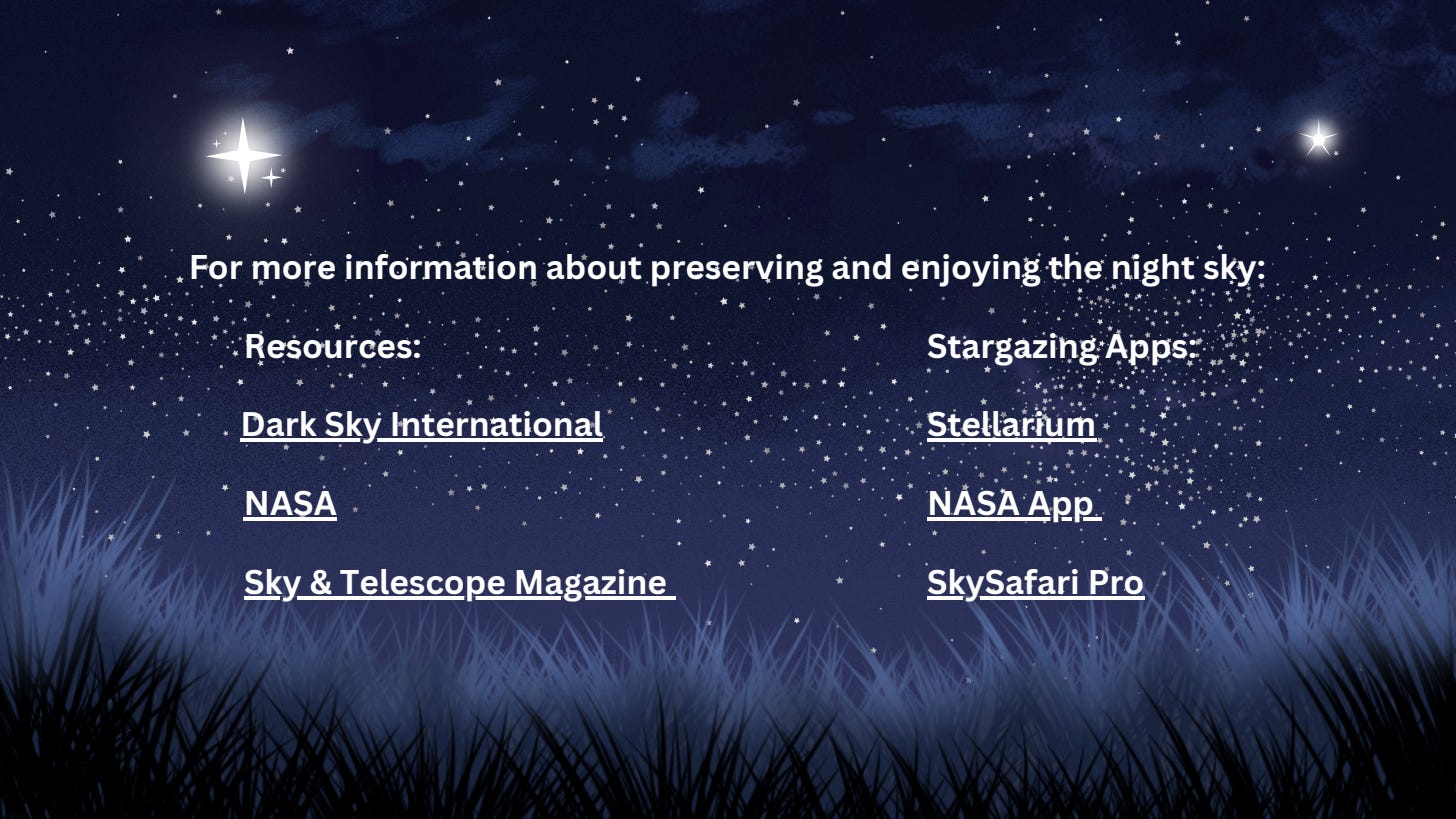A world without stars: the endless day is nearly here, warns astrophysicist
Dark skies advocate visits Berea to talk about dangers of light pollution

If we’d not been able to see clearly all the stars in the night sky, we would not have been able to develop navigation. All that has been discovered by mapping the stars would perhaps remain unknown to us.
If we’d not have had an understanding of the night sky, there would not have been an Apollo mission to the Moon. There would have been no “one step for all mankind”.
If we’d not known what we now do of the stars above — their light and heat, their lives and deaths, and their distance from us here on earth — we would not have come to know that we, ourselves, are made of star dust.
Why do these truths matter now to Bereans?
Because even in our rural location, we have light pollution, and with light pollution comes disconnection from one half of the sky, the portion that covers one half of our time on this planet.
Because the sky overhead is essential to our identity as one people — it covers us all, and is at the core of all peoples’ origin stories going back millennia.
Because our night sky is under threat.
Dark skies in jeopardy
Last month, the Loyal Jones Appalachian Center at Berea College hosted a two-part dark skies event, beginning with a lecture on the importance of maintaining the night sky’s integrity for its role in our sense of place. The talk was given by Jeff Bary, PhD, an advocate for dark skies, and the chair of physics and astronomy at Colgate University in New York State.

Bary, whose research interests include star formation, shared how as a child growing up in Welch, West Virginia, he couldn’t see the stars because of a neighbor who flooded the yard with so much light, it obliterated the view of the night sky.
It wasn’t until he was nine years old and on a Boy Scout camping trip in the wilderness, that Bary could see the stars in abundance. As he stood at the edge of a pond during the night, he saw the constellation Orion reflected back to him. He looked up to see the whole of it overhead, and upon seeing a red star in Orion’s shoulder — which he later learned was named Betelgeuse — he was inspired to learn more, eventually becoming an astrophysicist.
“Even though I was growing up in the heart of Appalachia, I still had to travel two hours to have that experience,” Bary told his audience.
Bary said this disregard for the night both contributes to and is the result of our having been entrained to see ourselves as separate from nature, dominating it, rather than existing as part of it. “Nature is what we visit, not inhabit,” he said. “We learn to fear what is not under human control.”
Now that civilization has attempted to control the night, we are in danger of losing it entirely, he said.
Endless light is destructive
In 2016, scientists warned that without more attention paid to light pollution, we would lose the night sky altogether. They shared their findings that more than 80% of the entire world and nearly 100% of US and European populations live under light-polluted skies. The Milky Way, once visible the world over a mere 50 years ago, is now hidden from more than a third of all humanity — including 80% of North Americans, the researchers found.
This loss of nighttime is deleterious not just to thieves and romantics, but to all of us. Multiple studies have found that our bodies need dark as much as they need light, which makes living on a planet that never sleeps risky. Never-ending light has been shown to interfere with our body’s capacity to manufacture melatonin — an essential hormone for sleep and for protecting the body from certain cancers, such as breast, colorectal, and prostate. Melatonin disruption has also been associated with depression due to lack of good sleep and rest.
Other studies have implicated light pollution in metabolic disorders, making it a factor in our global obesity epidemic.
Infinite light is known to harm wildlife. Birds’ migration patterns, wake-sleep habits, and habitat formation become deranged by too much light, observational studies have found. Because of light pollution, sea turtles and birds guided by moonlight during migration get turned around, lose their way, and are often killed by motorists, or die before they get where they were going, according to multiple studies.
“Light pollution needs to be addressed immediately because, even though it can be instantly mitigated (by turning off lights), its consequences cannot (for example, loss of biodiversity and culture),” wrote the light pollution study’s authors.

Darkness for healing
Poet Ansel Elkins remembers walking through the woods on moonlit nights growing up in rural Alabama. “I took for granted that I would always have that connection with the stars and the night. It was always a part of who I am,” Elkins told The Edge in an interview. Elkins is a visiting assistant professor of creative writing at the College.
Since leaving Alabama, Elkins’ academic career has taken her to more urban environments where, after battling what she said was akin to depression, but she didn’t know quite what it was, she found herself once again in the wilds, enjoying the night sky, and the mystery of wait ailed her was revealed.
“I was in coastal Connecticut, and was taking these nighttime walks. I could see the stars and a little bit of the Milky Way. I would just live for those walks,” Elkins said. “Then I realized, ‘this is what I am missing’.”
Inspired by Johan Eklöf’s, The Darkness Manifesto, a lyrical work of appreciation for the beauty of darkness set against the cost of light pollution to our health and that of the Earth’s, Elkins began interjecting her love of the stars into her creative writing classes. In 2023, she took her students to Big South Fork National River and Recreation Area in Tennessee, an International Dark Sky Park, so named because it has some of the last remaining truly dark skies anywhere in the world.
While entirely off-grid for a few days, Elkins and her students adjusted to the darkness of the night and to the peace and stillness.
“We communed with the wilderness of the night sky and opened our writing up to that,” Elkins said, and noted that she found her many of the students’ writing deepened and was more expressive as a result.
Stitched together with stars
The second evening of the Appalachian Center’s dark skies event featured a star party at Windswept, above Owsley Fork, where skies are among the darkest in our area. Students — including some of Elkins’ who’d been to Tennessee with her — gathered in the night with Bary and a couple of local amateur astronomers from the Pinnacles Astronomy Club, who set up their telescopes and trained them on Jupiter, Saturn, the Orion Nebula, and more. Some attendees even saw a shooting star.
“It’s really important just how the sky connects people together,” Bary told The Edge in a phone interview. “It makes me sad to think that there are people who can’t see this awesome thing that we all share in common.”
A dissertation on how college students from urban environments adapted to living on campus in a rural setting unlike anything they’d previously experienced, found that a sense of community developed among students who shared time in nature. In particular, the students who’d never seen more than a few stars in the sky reported bonding over their shared sense of wonder at the night sky, and feeling that it gave them a common connection to their sense of their “place” in the world.
“One of the reasons that the dark night sky is not part of the scholarship of what is a ‘sense of place’ is perhaps because too few people have the opportunity to experience a truly dark sky.”
The students in the rural setting endorsed this, reporting that until they’d relocated to the rural campus, they’d never felt connected to the stars in a way that infused them with belonging.
Reversing the creep of nonstop day
Is the loss of darkness inevitable? No, says Bary. “I think we might be able to tilt the future in our favor, and in terms of environmental issues, lighting is an easy one to solve because all you have to do is make the lights a little dimmer and put a shield on them, and turn them off when they don’t need to be on,” he told The Edge.
Aside from public safety advocates, whose concerns are often addressed by innovating how municipalities operate their lighting, there aren’t teams of lobbyists in favor of light pollution like there are for the coal and petroleum industries, either, according to Bary. “It’s easier to start with just not using so much light,” he said. “Start there.”
Simple steps that night sky preservationists like Bary and others, such as the nonprofit DarkSky International, say can help curb light pollution include not using lights on the blue spectrum, but sticking with the warmer spectrum. That’s because warmer light scatters less than does blue. Shielding outdoor lights so the light is focused in one place is another countermeasure. Also, setting outdoor lights on a timer to go off when not in use, or simply turning them off.
At the municipal level, in addition to the above recommendations, DarkSky also has templates for commercial and residential light ordinances specifying wattage for lights that balance safety with minimizing light pollution. There are also templates governing nighttime sports lighting.

Flagstaff, Arizona has one of the most comprehensive light pollution ordinances in the nation. Viewing light pollution as a “nuisance” that interferes with the affected neighbors’ enjoyment of their property, Flagstaff specifies that all outdoor lighting must be shielded, on a warmer spectrum, and is not considered “over-lighting”.
No one was available for comment in the Berea City Codes department at the time of publication, but a look at Berea’s outdoor light code shows that while it is not as specific as Flagstaff’s, it does require shielding, and it does have a provision to address light as a nuisance. It does not, however, specify wattage or spectrum.
“When I was in Berea, I was a little surprised that some of the street lamps were super bright and on the blue spectrum. So, there are some improvements that could be done in Berea,” Bary told The Edge.
Night light addiction
If the evidence is overwhelming that 24/7 light is bad for humans, animals, and the Earth, why do we keep lighting up the night sky?
“There are some powerful forces just trying to sell us on ideas. I don’t know why lighting matters so much, but those forces do like to prey on people’s fears of the dark, which we are taught to have from a young age,” Bary said in the interview. “And if you are afraid of the dark, why wouldn’t you want to have the lights on all the time?”
Which begs the question, whose interest does it serve to make humans so scared of the dark we willingly demolish our relationship to the sky? If our actions aren’t in our best interest, but simply the result of a learned behavior, evidence suggests it’s a behavior to unlearn, now.

Update: This story was updated on Friday, March 14, 2025, at 2:29pm to say that the astronomers who held the star party were from the Pinnacles Astronomy Club.



